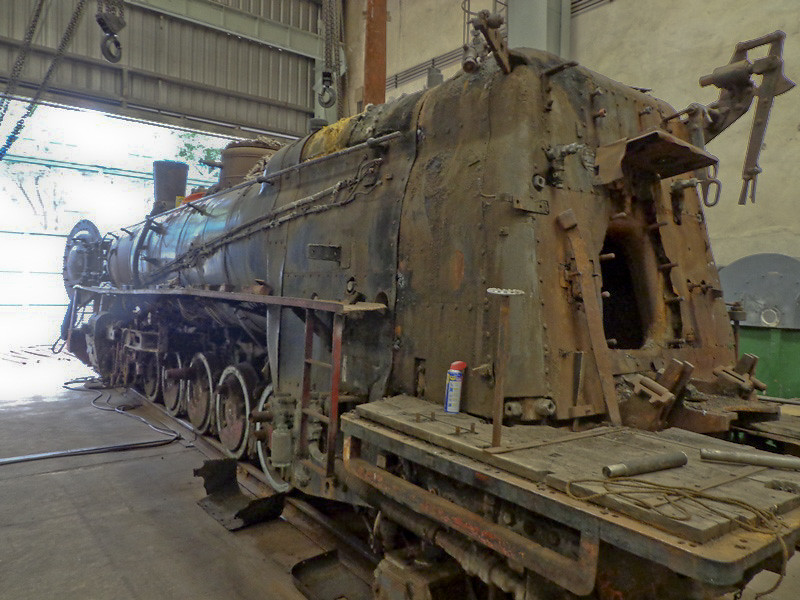Once repaired, 3461 continued West, using pushers where required to make grades, and arrived in Los Angeles on time. Again, loosening fire brick was addressed in Los Angeles following the run, but this both marked the successful first major trip of advanced steam on the ATSF and proved that advanced steam could perform favorably in running time with the diesel-locomotives of the era (the EMC E-1s that had also been delivered to ATSF in 1937 - shown at RIGHT).
On December 9, 1937, locomotive 3461 took ATSF Train 8, the Fast Mail Express, out of La Grande Station in Los Angeles and headed east. The train consisted of 11 cars with a trailing weight of 757 tons. Assisted by various pusher engines through the mountainous West, the train made good time upgrade despite being involved in a grade crossing collision that delayed it by 57 minutes.
When the train reached Albuquerque, two additional cars were added, bringing the train to 13 cars and 917 tons. Again, a series of helper and pusher engines were added to the train to help it over the toughest grades on the railroad, including the 3.5% grade over Raton Pass. The helper and pusher locomotives that had aided Train 8 over Raton Pass were cut off at Wootton, and once the train reached La Junta, Colorado, one car was dropped, lowering the train to 12 cars and 830 tons.
Prior to La Junta, average speeds varied between 42.2 mph and 66.2 mph (67.9 kmh and 106.5 kmh), dependent upon ruling grade. From La Junta to Dodge City, Kansas, 3461 hauled its train at an average speed of 60.8 mph (97.8 kmh) over the 202 mi (325 km) run. At Newton, Kansas an additional car was added, bringing the train back to 13 cars and increasing its weight to 899 tons. Between Newton and Emporia, Kansas 3461 averaged 63.6 mph (102.4 kmh). From Emporia, through Topeka, and on to Kansas City, the train averaged 58.0 mph.
At Kansas City, a car was swapped off the train for another, increasing its weight to 939 tons. From Kansas City, Missouri to Shopton, Iowa, the train began to lose significant time, eventually departing Shopton some 69 minutes behind schedule. The last dash from Shopton to Chicago, however, had the train making up 47 minutes, arriving at Dearborn Station on December 12, 1937 53 hours and 40 minutes after departing Los Angeles.
The numbers of the run are quite impressive. Locomotive 3461 attained top speeds of 92 mph (148 kmh) on the Albuquerque Division and 90 mph (145 kmh) on the Colorado and Western Divisions. Total actual running time of the train was 43 hours, 17 minutes and 15 seconds, while the trip took 53 hours and 40 minutes (allowing adding / subtracting of cars, servicing of the train, stops at stations, and fueling / watering the locomotive).
Conclusively, this record breaking run was important in that it proved modern steam power on the ATSF could maintain similar performance as the diesel-electric power. Even with a heavier consist, 3461 was able to handle its train with comparable time to diesels on the lighter, streamlined Super Chief.
Following this historic run, no other steam-hauled trains have made such a distance without stopping for layover. The 3461 went on to be a "guinea pig" of sorts for the class of locomotives at the Santa Fe. In 1945, it was rebuilt at Topeka to include the addition of a 25" long combustion chamber that included the addition of one safety circulator and two duplex siphons, increasing the direct heating surface in the firebox from 280 to 325 ft2 (26.0 to 30.2 m2). Because of the location of the steam dome in the boiler, however, this addition had the unwanted consequence of lifting water into the dry pipe and down into the superheaters, causing issues with steaming and corrosion.
Details of the 3461's modifications, and the historic 3460 class as a whole, will be included in an upcoming CSR White Paper on the locomotives.
The 3460 class of locomotives served the Santa Fe for nearly two decades, eventually being retired between 1954 and 1956. The engines reliably hauled passenger trains at speeds of between 90 and 100 mph over the ATSF, handling trains in excess of 2,000 tons without issue.
Stay tuned to CSR for more information on the class. As always, if you enjoy what you read, consider making a tax deductible donation to our organization to support our research, preservation and innovation.
--
Thanks is due to the Center for Railroad Photography & Art who has graciously provided CSR with rare images of the 3460 Class of locomotives taken by Wallace W. Abbey, including the cover photograph.
Sources for this article include:
- Brasher, Larry E. Santa Fe Locomotive Development. Wilton, CA: Signature Press, 2006.
- Farrington, Jr., S. Kip. The Santa Fe's Big Three. New York: David McKay Co., Inc., 1972.
- Smith, Vernon L. One Man's Locomotives. Glendale, CA: Trans-Anglo Books, 1987.






